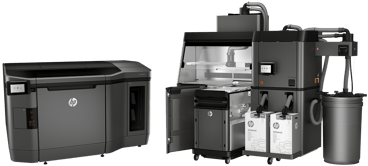Is industrial 3D printing a better fit for your part than your current manufacturing process? It could very well be—you just may not know it yet!
The reality is that the traditional manufacturing supply chain is precarious and
unpredictable. If the supplier you’re relying on goes out of business suddenly or decides to double the price of your part, where does that leave you? (That second scenario recently happened to one of our customers with their injection molding supplier!)
The COVID-19 pandemic has further highlighted the vulnerability of global supply chains. The digital, localized, on-demand nature of 3D printing, on the other hand, has proven invaluable in the face of unforeseeable events and geopolitical risk.

Even if there aren’t any obvious issues with your current manufacturing process, it’s still a best practice to reevaluate existing product lines every 2-5 years and optimize accordingly.
You may have decided against 3D printing a few years ago, but that doesn’t mean it’s off the table forever. 3D printing technology is constantly evolving, and it’s possible to achieve more now than ever before.
Is Industrial 3D Printing the Right Fit for Your Existing Part?
Ready to reevaluate your manufacturing process to see if 3D printing is the right fit for your part? Here are a few factors to consider:
- Volume. Due to recent advancements in technology, 3D printing isn’t just for prototyping anymore. It’s also a viable option for production. With our current 3D printing technology, RE3DTECH successfully completes and continues to supply numerous production projects on a weekly and monthly basis. We can achieve production quantities of up to 10,000.
- Material. If you have some flexibility with your material selection, industrial 3D printing can be a great option for your part. It’s common to transition from CNC machining aluminum parts to 3D printing them using a robust thermoplastic like Nylon 12, for example. Nylon 12 produces high-density parts with balanced property profiles and strong structures.
- Tolerances. It’s true that 3D printing can’t produce tolerances as tight as CNC machining. But we often find that the tolerances indicated on drawings are much tighter than the part actually requires. If your part is embedded within another component in an assembly, there’s probably an opportunity to simplify it considerably. Some parts might not even need tolerances at all. If you have flexibility regarding tolerances, it’s definitely worth looking into industrial 3D printing as an alternative to CNC machining.
Keep in mind that designing for additive manufacturing is different from designing for CNC machining or injection molding. You may need to update your design for 3D printing to achieve the highest quality and the best cost.
When in doubt, turn to an additive manufacturing partner like RE3DTECH early on in the process of transitioning to industrial 3D printing. We can help you optimize your design and identify the ideal 3D printing technology for your part. And we’ll always be upfront with you if we think your part isn’t a good fit for 3D printing.
Ready to use 3D printing services for your part? Request a quote today and let’s get started!
